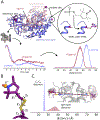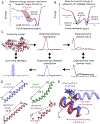Protein Modeling with DEER Spectroscopy
- PMID: 39689263
- PMCID: PMC12147563
- DOI: 10.1146/annurev-biophys-030524-013431
Protein Modeling with DEER Spectroscopy
Abstract
Double electron-electron resonance (DEER) combined with site-directed spin labeling can provide distance distributions between selected protein residues to investigate protein structure and conformational heterogeneity. The utilization of the full quantitative information contained in DEER data requires effective protein and spin label modeling methods. Here, we review the application of DEER data to protein modeling. First, we discuss the significance of spin label modeling for accurate extraction of protein structural information and review the most popular label modeling methods. Next, we review several important aspects of protein modeling with DEER, including site selection, how DEER restraints are applied, common artifacts, and the unique potential of DEER data for modeling structural ensembles and conformational landscapes. Finally, we discuss common applications of protein modeling with DEER data and provide an outlook.
Keywords: DEER; EPR spectroscopy; integrative modeling; spin labeling.
Figures





Similar articles
-
Spin labeling and Double Electron-Electron Resonance (DEER) to Deconstruct Conformational Ensembles of HIV Protease.Methods Enzymol. 2015;564:153-87. doi: 10.1016/bs.mie.2015.07.019. Epub 2015 Sep 1. Methods Enzymol. 2015. PMID: 26477251 Free PMC article.
-
Tracking protein domain movements by EPR distance determination and multilateration.Methods Enzymol. 2022;666:121-144. doi: 10.1016/bs.mie.2022.02.016. Epub 2022 Mar 17. Methods Enzymol. 2022. PMID: 35465918
-
High-Pressure EPR and Site-Directed Spin Labeling for Mapping Molecular Flexibility in Proteins.Methods Enzymol. 2015;564:29-57. doi: 10.1016/bs.mie.2015.07.004. Epub 2015 Sep 9. Methods Enzymol. 2015. PMID: 26477247
-
Exploring protein conformations in vitro and in cell with EPR distance measurements.Curr Opin Struct Biol. 2022 Aug;75:102398. doi: 10.1016/j.sbi.2022.102398. Epub 2022 Jun 3. Curr Opin Struct Biol. 2022. PMID: 35667279 Review.
-
Characterization of conformationally heterogeneous proteins by electron paramagnetic resonance spectroscopy.Curr Opin Struct Biol. 2025 Jun;92:103046. doi: 10.1016/j.sbi.2025.103046. Epub 2025 Apr 11. Curr Opin Struct Biol. 2025. PMID: 40220482 Review.
Cited by
-
Capturing protein dynamics across timescales with site-directed spin labeling electron paramagnetic resonance spectroscopy.Curr Opin Struct Biol. 2025 Aug;93:103073. doi: 10.1016/j.sbi.2025.103073. Epub 2025 Jun 9. Curr Opin Struct Biol. 2025. PMID: 40494166 Review.
-
ProGuide: a flexible framework for modeling global conformational rearrangements in proteins using DEER-derived distance restraints.bioRxiv [Preprint]. 2025 Jun 8:2025.06.05.658127. doi: 10.1101/2025.06.05.658127. bioRxiv. 2025. PMID: 40661650 Free PMC article. Preprint.
References
-
- Abdullin D 2020. AnisoDipFit: Simulation and Fitting of Pulsed EPR Dipolar Spectroscopy Data for Anisotropic Spin Centers. Appl. Magn. Reson, pp. 1–24
-
- Ahmed A, Rippmann F, Barnickel G, Gohlke H. 2011. A normal mode-based geometric simulation approach for exploring biologically relevant conformational transitions in proteins. J. Chem. Inf. Model 51(7):1604–22 - PubMed
Publication types
MeSH terms
Substances
Grants and funding
LinkOut - more resources
Full Text Sources

